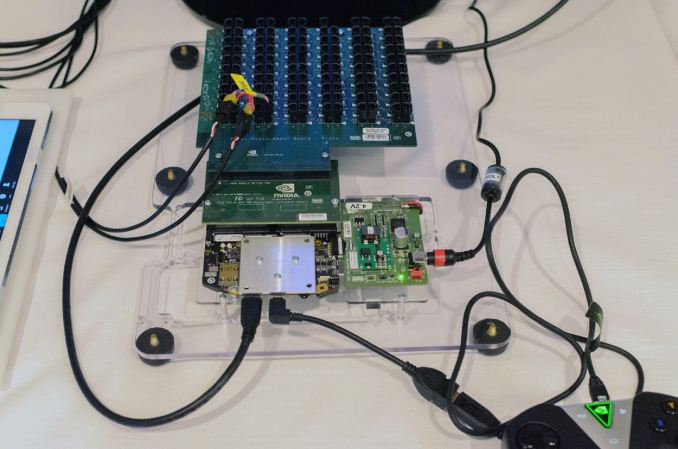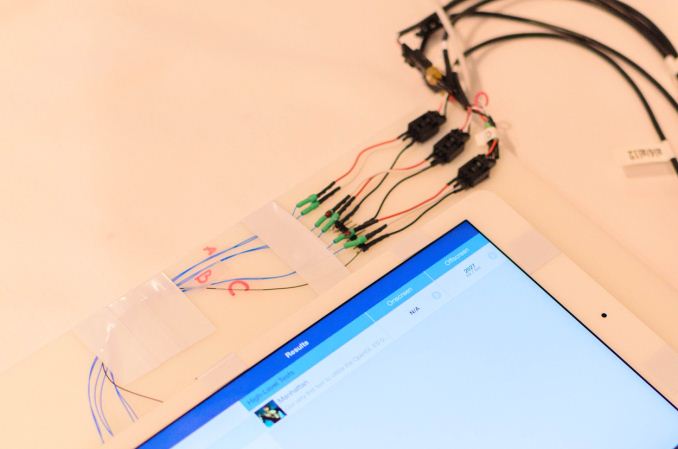NVIDIA Tegra X1 Preview & Architecture Analysis
by Joshua Ho & Ryan Smith on January 5, 2015 1:00 AM EST- Posted in
- SoCs
- Arm
- Project Denver
- Mobile
- 20nm
- GPUs
- Tablets
- NVIDIA
- Cortex A57
- Tegra X1
GPU Performance Benchmarks
As part of today’s announcement of the Tegra X1, NVIDIA also gave us a short opportunity to benchmark the X1 reference platform under controlled circumstances. In this case NVIDIA had several reference platforms plugged in and running, pre-loaded with various benchmark applications. The reference platforms themselves had a simple heatspreader mounted on them, intended to replicate the ~5W heat dissipation capabilities of a tablet.
The purpose of this demonstration was two-fold. First to showcase that X1 was up and running and capable of NVIDIA’s promised features. The second reason was to showcase the strong GPU performance of the platform. Meanwhile NVIDIA also had an iPad Air 2 on hand for power testing, running Apple’s latest and greatest SoC, the A8X. NVIDIA has made it clear that they consider Apple the SoC manufacturer to beat right now, as A8X’s PowerVR GX6850 GPU is the fastest among the currently shipping SoCs.
It goes without saying that the results should be taken with an appropriate grain of salt until we can get Tegra X1 back to our labs. However we have seen all of the testing first-hand and as best as we can tell NVIDIA’s tests were sincere.
| NVIDIA Tegra X1 Controlled Benchmarks | |||||
| Benchmark | A8X (AT) | K1 (AT) | X1 (NV) | ||
| BaseMark X 1.1 Dunes (Offscreen) | 40.2fps | 36.3fps | 56.9fps | ||
| 3DMark 1.2 Unlimited (Graphics Score) | 31781 | 36688 | 58448 | ||
| GFXBench 3.0 Manhattan 1080p (Offscreen) | 32.6fps | 31.7fps | 63.6fps | ||
For benchmarking NVIDIA had BaseMark X 1.1, 3DMark Unlimited 1.2 and GFXBench 3.0 up and running. Our X1 numbers come from the benchmarks we ran as part of NVIDIA’s controlled test, meanwhile the A8X and K1 numbers come from our Mobile Bench.
NVIDIA’s stated goal with X1 is to (roughly) double K1’s GPU performance, and while these controlled benchmarks for the most part don’t make it quite that far, X1 is still a significant improvement over K1. NVIDIA does meet their goal under Manhattan, where performance is almost exactly doubled, meanwhile 3DMark and BaseMark X increased by 59% and 56% respectively.
Finally, for power testing NVIDIA had an X1 reference platform and an iPad Air 2 rigged to measure the power consumption from the devices’ respective GPU power rails. The purpose of this test was to showcase that thanks to X1’s energy optimizations that X1 is capable of delivering the same GPU performance as the A8X GPU while drawing significantly less power; in other words that X1’s GPU is more efficient than A8X’s GX6850. Now to be clear here these are just GPU power measurements and not total platform power measurements, so this won’t account for CPU differences (e.g. A57 versus Enhanced Cyclone) or the power impact of LPDDR4.
Top: Tegra X1 Reference Platform. Bottom: iPad Air 2
For power testing NVIDIA ran Manhattan 1080p (offscreen) with X1’s GPU underclocked to match the performance of the A8X at roughly 33fps. Pictured below are the average power consumption (in watts) for the X1 and A8X respectively.
NVIDIA’s tools show the X1’s GPU averages 1.51W over the run of Manhattan. Meanwhile the A8X’s GPU averages 2.67W, over a watt more for otherwise equal performance. This test is especially notable since both SoCs are manufactured on the same TSMC 20nm SoC process, which means that any performance differences between the two devices are solely a function of energy efficiency.
There are a number of other variables we’ll ultimately need to take into account here, including clockspeeds, relative die area of the GPU, and total platform power consumption. But assuming NVIDIA’s numbers hold up in final devices, X1’s GPU is looking very good out of the gate – at least when tuned for power over performance.














194 Comments
View All Comments
eanazag - Wednesday, January 7, 2015 - link
I'm not totally sure why all the NV and Apple back and forth. I see this as an Apple competitive chip for Android tablets. Why would Apple jump the Imag. Tech ship? At release time they have had the best GPU in a SOC for their iPads. ImgTech has been good for Apple iteration over iteration.May Apple be interested in licensing some IP from NV? Maybe. Apple does a lot of custom work and has a desire to remain in the lead on the mobile SOC front at device release.
lucam - Wednesday, January 7, 2015 - link
Old news, after 2 years nobody knows what happened since then.mpeniak - Thursday, January 8, 2015 - link
Totally!!!jwcalla - Monday, January 5, 2015 - link
It seems like Denver was a huge investment that has produced virtually no fruit so far.Time to market seemed to be NVIDIA's problem with Tegra in the past so it does make sense to get Maxwell out the door ASAP.
syxbit - Monday, January 5, 2015 - link
Exactly. Denver has been a massive disappointment. It really needs to be on 20nm. At 28nm performance is too inconsistent, and throttles too much.I just find it funny how arrogant Nvidia is. They're always boasting and boasting with these announcements, and yet by the time they ship, they're rarely leading (or in the case of the K1, they're leading, but in literally only 1 shipping device).
djboxbaba - Monday, January 5, 2015 - link
Yes! How can they keep going about this on a yearly basis, disappointment after disappointment from NVidia in the mobile sector.Krysto - Monday, January 5, 2015 - link
Denver needs to be at 16nm. And we might still see it, at the end of the year/early next year if Nvidia releases the X1 on 20nm, and then X2 (I really hope they don't release another "X1", like they did this year with K1, making things very confusing) with Denver and on 16nm.name99 - Monday, January 5, 2015 - link
Unlikely that nV will release 16FF this year or early next year. Apple has likely booked all 16FF capacity for the next year or so, just like they did with 20nm. nV (and Qualcomm and everyone else) with get 16FF when Apple has satisfied the world's iPhone 6S and iPad 2015 demands...GC2:CS - Monday, January 5, 2015 - link
Yep.Like on the presentation, boasting about how Tegra K1 is still the best mobile chip (despite A8X matching it at significally lower power (which they don't have a graph for)) despite being released a "year before", while A8X has been released just "now". (While taking nVidia's logic A8X was "released" just few hours after K1 because imagination had annonced Series 6XT GPU's at CES 2014).
Yojimbo - Monday, January 5, 2015 - link
Tegra K1 is a 28nm part and the A8X is a 20nm device. The Shield tablet did launch 3 months before the iPad Air 2. Apple has a huge advantage in time to market. They can leverage the latest manufacturing technologies, and they don't have to demonstrate a product and secure design wins. Even though the shield tablet is an NVIDIA design, I doubt they have such tight control of their suppliers as Apple has, and they can't leverage the same high-volume orders. Apple designs a chip and designs a known product around that chip while the chip is being designed, and they can count on it selling in high volume. So you are making an unfair comparison of what NVIDIA is able to do and of the strength of the underlying architecture. If you want to compare the Series 6XT GPU architecture with K1's GPU architecture I think it should be done on the same manufacturing technology.